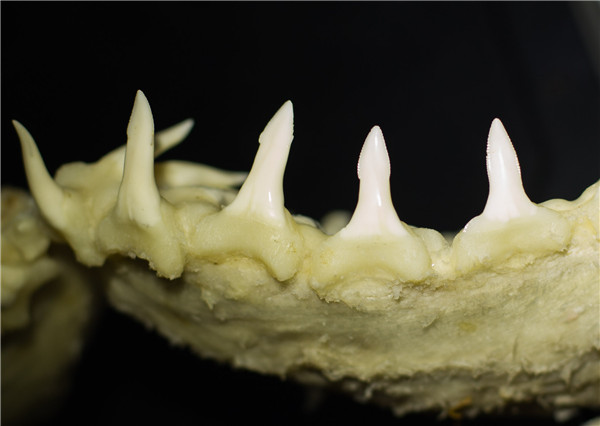Rare speartooth sharks caught in Australia
 0 Comment(s)
0 Comment(s) Print
Print E-mail China.org.cn, November 11, 2015
E-mail China.org.cn, November 11, 2015
 |
|
The lower teeth of the speartooth shark, which are long, narrow and erect with spear-like tips. The upper teeth are broadly triangular, erect and serrated. [Photo/CSIRO] |
While one of the sharks was a female approximately 2.2m in length, the other individual was a mature male of 2.3m in length, which was somewhat of a surprise and may indicate that the pupping area is also a mating area.
"Both individuals were tagged with satellite tags that will detach after approximately two months and provide information on where the sharks have moved to in this time," Dr Pillans said.
"The tags also collect water temperature and depth which can be used to reconstruct the movement pathways and provide detailed information on the habitat preferences of this species.
"It is hoped that the information obtained from these tags will provide the first data on where adult Speartooth Shark live, with this data critical to obtaining a better understanding of threats to this endangered species.
"We currently have no idea where the adults occur, all we know is that they are found in marine environments somewhere off the northern Australian coast."
The Speartooth Shark is a species of whaler shark and is often confused with bull sharks given their similar colouration and preference for riverine habitats.
The Speartooth Shark is characterised by its dark grey dorsal colouration, a large second dorsal fin and narrow spear-like teeth in the lower jaw which is where it gets its name from.
The Speartooth Shark gives birth to live young with the juveniles thought to be born at the mouths of a few rivers systems in northern Australia.
Once born, the young are completely self-reliant and move upstream where they spend the next three to six years about 40km to 80km from the river mouth in water of reduced salinity.
During the annual monsoon, juveniles move downstream to avoid the influx of freshwater but move back upstream once freshwater flows ease and salinity returns to their preferred range.






Go to Forum >>0 Comment(s)